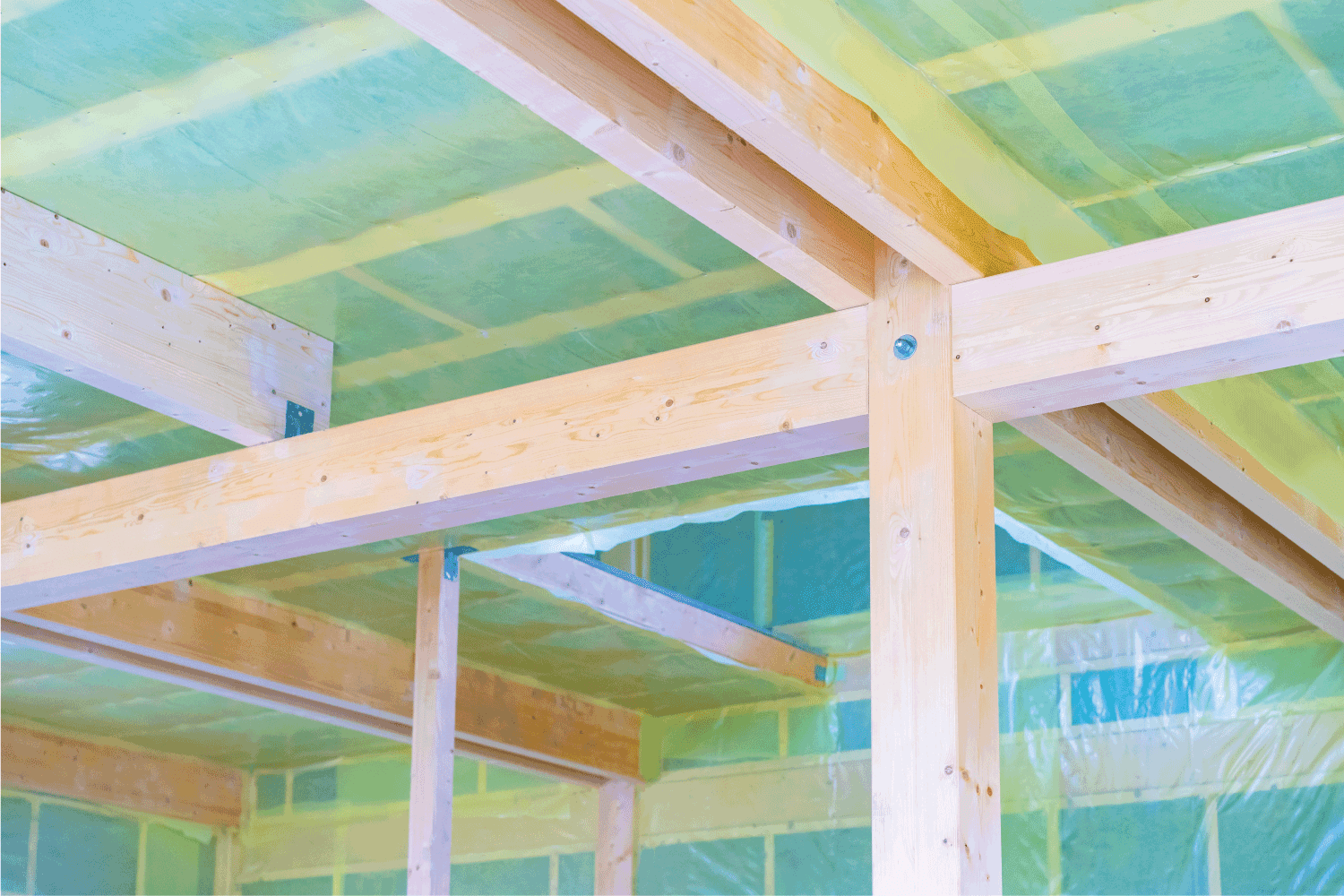As the autumn and winter months approach, insulating windows and door openings may be a crucial step to help keep out cold drafts. However, if your home is newly constructed, you may be wondering what the best method is to insulate your windows. We have researched a few notable techniques to consider.
Insulating new construction windows can be done several ways. Here are a few common approaches to consider:
- Apply caulk to the frame
- Use weatherstripping
- Apply spray foam
- Use draft stopper
- Apply a high-performance sealant
A single window pane can lose almost 8-10 times as much heat as a floor or wall. This means that effective insulation is essential when it comes to protecting your home from extreme temperatures. It also means that if you want to keep your energy bills down, making sure the windows are insulated properly is worth the effort. Keep reading for an in-depth look at properly insulating new construction windows.

What kind of insulation do you put around windows?
While insulating windows in new construction homes is fairly similar to insulating those of an older home, there are a few things to note.
For example, you may want to take a look at the window frame to ensure that there are no gaps or holes in the caulk or insulation around the windows. If there are, you'll want to fix these areas before applying any insulative barriers.

Apply caulk to the frame
One method that you can use is to apply caulk to the area around the window frame. If the area is already caulked, you can apply caulk over it to fill any gaps. The great thing about caulk is that it is relatively easy to apply, and it's fairly inexpensive.
On the downside, you may need to strip away and re-apply the caulk after a few years—particularly if it is applied to the exterior of the window.
It's best to use a silicone-based caulk on windows that have a glass or metal surface around the frame. And a water-based caulk will work best for wood frames.
Click here to see this silicone-based caulk on Amazon.
Use weatherstripping
You can also use weatherstripping to help prevent drafts from coming in through the window frame. The good thing about weatherstripping is that it is inexpensive and can be applied in minutes. It also doesn't leave any mess or residue after it is removed.
If the window remains shut during the entire winter, you can apply the stripping to the entire frame. Note that weatherstripping comes in two forms.
You can use weather seal tape that has an adhesive backing, which allows it to stay in place longer and is more resistant to tampering.
Or you can use the typical bubble weatherstripping made from foam or felt. This type of weatherstripping is better for areas that have larger gaps that need to be filled. You can also cut the weather sealing strips to match the size of the windows.
Click here to see this weather stripping on Amazon.
Apply spray foam
If you have an easily accessible or fairly small gap around your window, spray foam may be a great option to fill it. Spray foam sealant works well to insulate the area around the window and can be used on all types of materials, including wood, glass, and metal.
The foam can comes with an attached nozzle that allows you to reach small cracks within the window frame to provide the perfect seal.
After application, the foam will expand to fill out the wall cavity around the window, helping to keep drafts out. If you have a window with a relatively small space that needs to be filled, you can also purchase a low expansion foam as well.
Click here to see this spray foam sealant on Amazon.
Use draft stoppers
You may typically see draft stoppers, also known as draft snakes, used to help block gaps beneath doors. But you can also use these to insulate the area around your newly constructed windows as well.
They are especially effective at blocking the draft between the window frame and the bottom area of the window sash. Draft stoppers are relatively cheap and easy to install. And as an extra benefit, they can also work as a great soundproofing material.
Click here to see this draft stopper on Amazon.
Apply a high-performance sealant
A high-performance sealant is one specially made to provide high-quality insulation around windows and doors. Essentially, it's a liquid sealant that expands into foam upon application.
High-performance sealants are very durable and will typically last a bit longer than caulk, weatherstripping, and other window frame insulation treatments.
They can usually be applied with a caulk gun and will need time to cure after application. Not only do these sealants block drafts but they also prevent mold and mildew from growing by preventing moist air from the outside from entering your home.
Click here to see this high-performance sealant on Amazon.
Do you need a vapor barrier around windows?
Vapor barriers are typically installed on the wall area around the windows when a new home is constructed. So essentially, yes, the area around windows will require some sort of vapor barrier.
However, you'll usually find this in the form of fiberglass insulation, weather stripping, or a sealant. So, it's not something you'll typically need to add to the window if you're moving into a new home.

Do you put windows in before insulation?
No. When a home is constructed, the insulation is typically added right after the framing has been completed. The windows are installed after this happens.
However, if you are replacing your windows, there may be scenarios where the insulation will require a replacement as well—as in cases where it's damaged or worn out.
If you're noticing cold drafts around your windows, the chances are that the insulation is worn out and needs to be replaced. The best thing to do is to determine where the draft is coming from and then seal the area as needed.
Can you insulate casement windows?
Yes, you can insulate casement windows just like any other window type. Doing so can help you keep your energy bills low and prevent your home's temperature from skyrocketing during the winter and summer months. Let's take a look at how to do it.
Things you'll need:
- Dish soap
- Cleaning cloths
- Shears
- Water
- Self-adhesive weatherstripping
- Tape measure
1. Open the window fully
Start by opening the window and cranking the knob clockwise until it is completely open.
2. Clean the window to ensure the adhesive sticks
Next, take your cleaning cloth and wet it. Then add a little soap to the cloth and run it along the face of the window to remove any debris and dirt. If any residue on the window proves difficult to remove, take a box cutter or caulk removing tool to scrape it off.
Be sure to angle the blade at 45 degrees to avoid scratching the surface of the window. After cleaning the window and wiping it down with dry cloths, let it sit for about 2 to 5 minutes so that the surface dries completely.
3. Measure the window
Next, take your measuring tape and measure the length and width of the frame to determine how much weatherstripping is needed. Write the measurements down on a sheet of paper.
4. Prepare and cut the adhesive
After jotting down your measurements, take your weatherstripping and cut it to the length of the window frame. You will likely need to cut multiple pieces, so make sure that you have enough for the entire size of the frame. After cutting all the strips, set them to the side.
5. Apply the adhesive
Next, take the weatherstripping and expose the adhesive backing. Then, starting with the length of the window, apply the adhesive to the frame's edge around the windows.
As you apply the strips, press them down with your fingers to ensure a tight bond to the edge of the frame.
![]()
Does caulking stop drafts?
Yes. In many scenarios, caulking around the window frame will help to prevent a draft from seeping through any cracks and gaps that it may have.
However, this is most effective when there is also insulation around the window as well. Caulking alone won't necessarily provide the window insulation necessary to keep a home's temperature regulated.
The best way to stop drafts completely is to provide insulating materials such as fiberglass insulation, weatherstripping, or a sealant to the area around the window.
If the space around the window is more than 3/8 of an inch wide, you can also use spray foam insulation to fill the gap or cavity.
Wrapping Things Up
We hope that this post has helped illustrate how to insulate new construction windows.
If you find that there is a prevalent draft in the area around your windows, the chances are that it is due to an open cavity. In this case, you can fill the space using one of the methods mentioned above.
However, note that the draft can also come from the window itself. If this is the case, you may want to consider using a protective film, insulating curtains, or other material to cover the window instead.
Be sure to check out our other posts before you go:
How Long Does It Take To Insulate A New House?
Should You Air Condition Your Garage? [Pros, Cons And How To]





